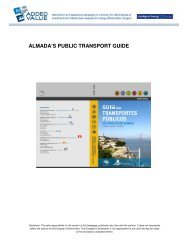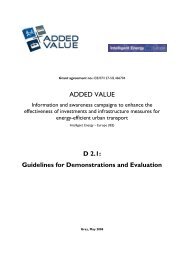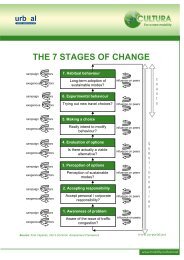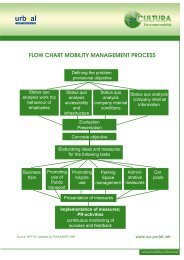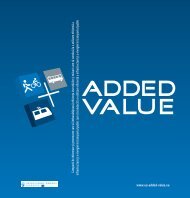SUMO - Eltis
SUMO - Eltis
SUMO - Eltis
You also want an ePaper? Increase the reach of your titles
YUMPU automatically turns print PDFs into web optimized ePapers that Google loves.
32<br />
8. Evaluation is simple when the levels<br />
have been monitored<br />
If preparations have been systematic and methodical, in accordance with this report,<br />
and there is sufficient know-how about evaluation methods, the monitoring and evaluation<br />
stage is simple to complete. Overall the monitoring and evaluation in accordance<br />
with <strong>SUMO</strong> offers an opportunity to:<br />
• compare with targets<br />
• compare with others<br />
• learn from results<br />
• collect data for research and analysis of cause and effect relationships.<br />
Evaluation can be defined as assessing something in a systematic and careful way. The<br />
difference between monitoring and evaluation is that monitoring involves measuring<br />
and describing events, while an evaluation involves deeper analysis and explanation of<br />
a change. Monitoring means the collection and storage and often compilation of data<br />
necessary later to interpret the impact of applied measures. Evaluation involves an<br />
analysis of collected data, such as estimates of reduced motorised vehicle mileage or<br />
changed transport habits etc. and to draw conclusions concerning cause and effect, etc.<br />
Ideally in an evaluation one has or carries out a pre study that is followed by one or<br />
more post studies over a period of time that allow improvements to the application.<br />
Post studies should be carried out at regular intervals adapted to the planned measures.<br />
If a retroactive evaluation of measures was necessary then the lack of a preliminary study<br />
(basic documentation/measurement of the initial situation) can to some extent be compensated<br />
for by asking questions retrospectively. However, this is not recommended as<br />
there is a high degree of uncertainty in such a method.<br />
Time aspects in monitoring and evaluation are important. Changing attitudes and<br />
behaviour takes time. The last two analysis levels often take one or several years before<br />
they can be measured.<br />
During the project, the results from the different levels are added successively as these<br />
become available or are measured. Examples of these are presented in Example 3 in the<br />
Appendix.<br />
In order to estimate the cost-efficiency of various measures, it may be a good idea also<br />
to document and monitor costs for the different measures and services. This is not actually<br />
included in <strong>SUMO</strong> but can be registered together with other results for the different<br />
levels of the project. Examples of expenses could be costs for in-house staff or con-<br />
sumo – System for Evaluation of Mobility Projects



